2015 VOLKSWAGEN POLO warning
[x] Cancel search: warningPage 76 of 100
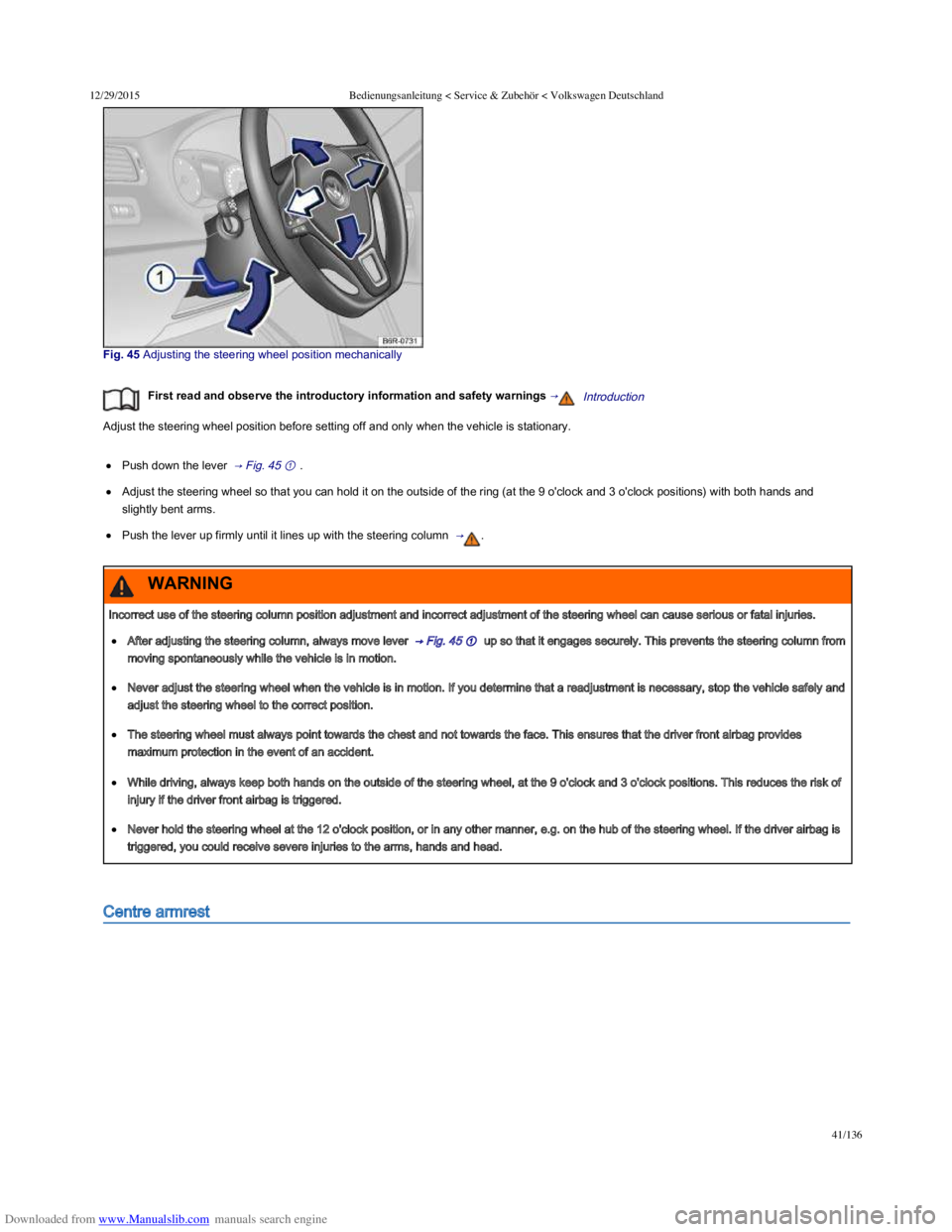
Downloaded from www.Manualslib.com manuals search engine 12/29/2015Bedienungsanleitung < Service & Zubehör < Volkswagen Deutschland
41/136
Fig. 45 Adjusting the steering wheel position mechanically
First read and observe the introductory information and safety warnings →Introduction
Adjust the steering wheel position before setting off and only when the vehicle is stationary.
Push down the lever → Fig. 45 ① .
Adjust the steering wheel so that you can hold it on the outside of the ring (at the 9 o'clock and 3 o'clock positions) with both hands and
slightly bent arms.
Push the lever up firmly until it lines up with the steering column → .
Centre armrest
Incorrect use of the steering column position adjustment and incorrect adjustment of the steering wheel can cause serious or fatal injuries.
After adjusting the steering column, always move lever → Fig. 45 ① up so that it engages securely. This prevents the steering column from
moving spontaneously while the vehicle is in motion.
Never adjust the steering wheel when the vehicle is in motion. If you determine that a readjustment is necessary, stop the vehicle safely and
adjust the steering wheel to the correct position.
The steering wheel must always point towards the chest and not towards the face. This ensures that the driver front airbag provides
maximum protection in the event of an accident.
While driving, always keep both hands on the outside of the steering wheel, at the 9 o'clock and 3 o'clock positions. This reduces the risk of
injury if the driver front airbag is triggered.
Never hold the steering wheel at the 12 o'clock position, or in any other manner, e.g. on the hub of the steering wheel. If the driver airbag is
triggered, you could receive severe injuries to the arms, hands and head.
WARNING
Page 77 of 100
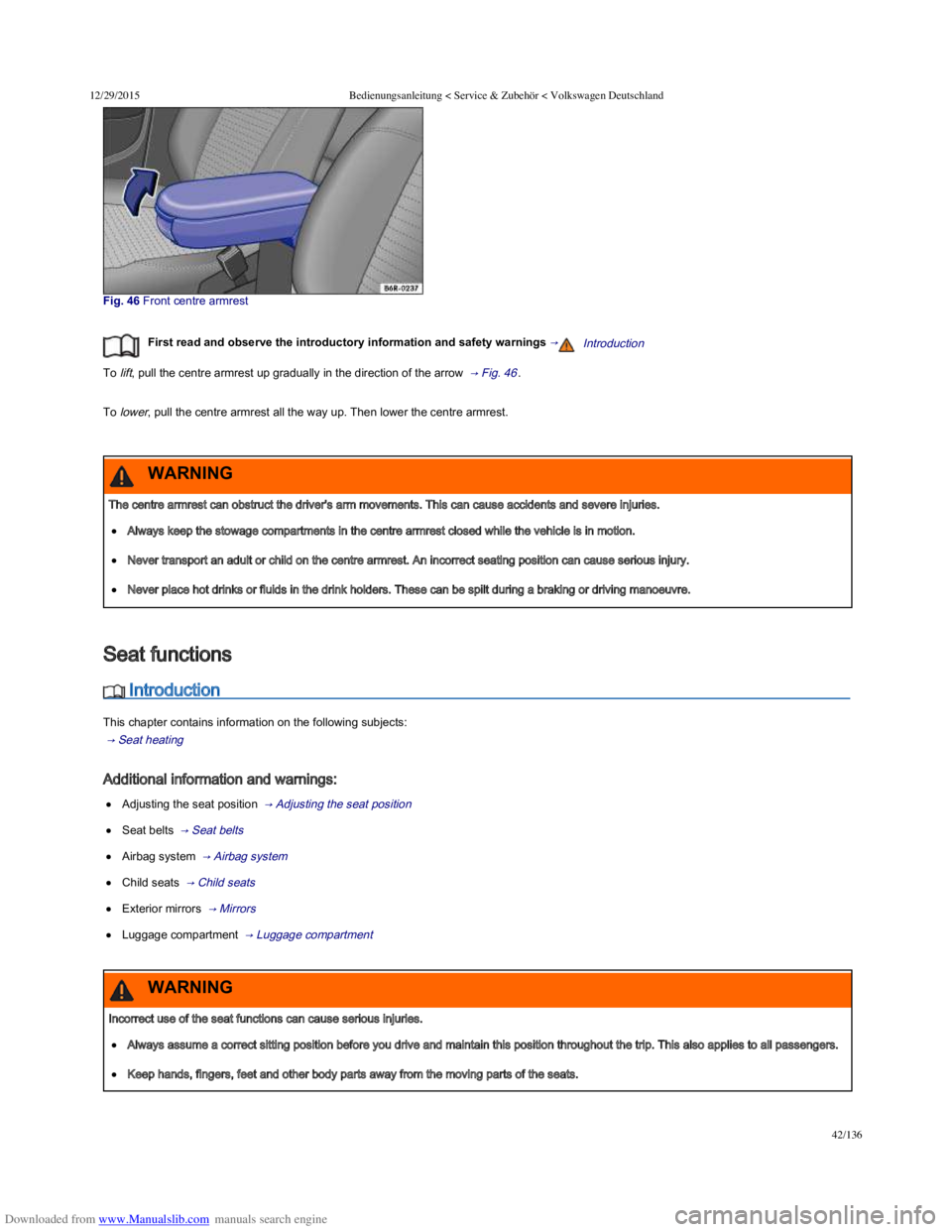
Downloaded from www.Manualslib.com manuals search engine 12/29/2015Bedienungsanleitung < Service & Zubehör < Volkswagen Deutschland
42/136
Fig. 46 Front centre armrest
First read and observe the introductory information and safety warnings →Introduction
To lift, pull the centre armrest up gradually in the direction of the arrow → Fig. 46 .
To lower, pull the centre armrest all the way up. Then lower the centre armrest.
Introduction
This chapter contains information on the following subjects:
→ Seat heating
Additional information and warnings:
Adjusting the seat position → Adjusting the seat position
Seat belts → Seat belts
Airbag system → Airbag system
Child seats → Child seats
Exterior mirrors → Mirrors
Luggage compartment → Luggage compartment
Seat heating
The centre armrest can obstruct the driver's arm movements. This can cause accidents and severe injuries.
Always keep the stowage compartments in the centre armrest closed while the vehicle is in motion.
Never transport an adult or child on the centre armrest. An incorrect seating position can cause serious injury.
Never place hot drinks or fluids in the drink holders. These can be spilt during a braking or driving manoeuvre.
WARNING
Seat functions
Incorrect use of the seat functions can cause serious injuries.
Always assume a correct sitting position before you drive and maintain this position throughout the trip. This also applies to all passengers.
Keep hands, fingers, feet and other body parts away from the moving parts of the seats.
WARNING
Page 78 of 100

Downloaded from www.Manualslib.com manuals search engine 12/29/2015Bedienungsanleitung < Service & Zubehör < Volkswagen Deutschland
43/136
Seat heating
Fig. 47 In upper part of centre console: buttons for the front seat heating
First read and observe the introductory information and safety warnings →Introduction
The seat cushions on the front seats can be heated electrically when the ignition is switched on. In some versions, the backrests may also be
heated.
Do not switch on the seat heating if one of the following conditions applies:
The seat is not in use.
The seat is fitted with a protective cover.
A child seat is installed on the seat.
The seat cushion is damp or wet.
The interior or exterior temperature is above 25°C (77°F).
FunctionAction
Switching onPress the button. The seat heating is switched on at maximum level and all indicator
lamps in the button are lit up → Fig. 47 .
Adjusting the heating outputPress the button repeatedly until the desired heating level is set.
Switching off
Press the button until the indicator lamps in the button go out.
OR: switch off the ignition.
If the second temperature level has been switched on for more than 15 minutes, it will automatically switch to the first temperature level. Only one
indicator lamp will be lit up.
Anyone experiencing reduced sensitivity to pain or temperature due to medication, paralysis or chronic illness (e.g. diabetes) could sustain
burns on the back, buttocks and legs when using the seat heating. These burns may take a long time to heal or may never heal fully. Please
consult a doctor to determine your own level of health.
Anyone experiencing reduced sensitivity to pain or temperature should never use the seat heating.
WARNING
Page 79 of 100

Downloaded from www.Manualslib.com manuals search engine 12/29/2015Bedienungsanleitung < Service & Zubehör < Volkswagen Deutschland
44/136
The seat heating should be switched off as soon as it is no longer needed. Fuel is otherwise wasted.
Introduction
This chapter contains information on the following subjects:
→ Warning lamp
→ Frontal collisions and the laws of physics
→ What happens to vehicle occupants who have not fastened their seat belts
→ Seat belt protection
→ Using seat belts
→ Fastening and unfastening seat belts
→ Seat belt routing
→ Belt height adjuster
→ Automatic belt retractor, belt tensioner, belt tension limiter
→ Service and disposal of belt tensioners
Check the condition of all seat belts regularly. If the belt webbing, belt connections, belt retractor or seat belt buckle become damaged, the seat
belt in question should be replaced immediately by a qualified workshop → . The qualified workshop must use correct spare parts that are
compatible with the vehicle, equipment level and model year. Volkswagen recommends using a Volkswagen dealership for this purpose.
Additional information and warnings:
Adjusting the seat position → Adjusting the seat position
Airbag system → Airbag system
Child seats → Child seats
Stowage → Stowage areas
Cleaning and caring for the interior → Cleaning and caring for the interior
Accessories, modifications, repairs and renewal of parts → Accessories, modifications, repairs and renewal of parts
Wet upholstery can cause a fault in the seat heating and increase the risk of burns.
Make sure that the seat cushion is dry before using the seat heating.
Do not sit on the seat when wearing damp or wet clothing.
Do not set any damp or wet objects or items of clothing on the seat.
Do not spill any liquids on the seat.
WARNING
To avoid damaging the heating elements, do not kneel on the seat or apply sharp pressure at a single point on the seat cushion and
backrest.
Liquids, sharp objects and insulating materials such as a protective cover or child seat on the seat could damage the seat heating.
If the system starts to emit a smell, switch the seat heating off immediately and have it checked by a qualified workshop.
NOTICE
Seat belts
Page 80 of 100

Downloaded from www.Manualslib.com manuals search engine 12/29/2015Bedienungsanleitung < Service & Zubehör < Volkswagen Deutschland
45/136
Warning lamp
Incorrectly fastened or unfastened seat belts increase the risk of severe or fatal injuries. Seat belts will only offer the optimum level of protection
when they are fastened and used properly.
Seat belts are the most effective means of reducing the risk of serious and fatal injuries in the event of an accident. Seat belts must always
be fastened properly when the vehicle is in motion to protect the driver and all vehicle occupants.
Before every trip, each vehicle occupant must adopt the correct sitting position, correctly fasten the seat belt belonging to their seat and
keep it fastened properly throughout the trip. This applies to all vehicle occupants and also in urban traffic.
While the vehicle is in motion, secure all children travelling in the vehicle in a restraint system suitable for their weight and height. They must
also wear correctly fastened seat belts → Child seats .
Only start driving when all passengers have correctly fastened their seat belts.
Only ever insert the latch plate into the buckle of the associated seat, and always ensure that it engages properly. Using a buckle that does
not belong to the seat that you are occupying reduces the level of protection and can lead to severe injuries.
Avoid allowing foreign bodies or liquids to enter the slot for the seat belt buckle. This could prevent the belt buckle and seat belt from
working properly.
Never unfasten the seat belt while the vehicle is in motion.
Never allow more than one person to share the same seat belt.
Never travel when children or babies are being carried on somebody's lap and fastened with the same belt.
Never travel wearing loose, bulky clothing (such as an overcoat over a jacket). This could prevent the seat belts from fitting and functioning
properly.
WARNING
Damaged seat belts are very dangerous and can cause severe or fatal injuries.
Never damage the belt by trapping it in the door or in the seat mechanism.
If the belt webbing or any other part of the seat belt becomes damaged, the seat belt may tear during an accident or sudden braking
manoeuvre.
Have damaged seat belts immediately replaced by new seat belts that have been approved by Volkswagen for the vehicle. Seat belts
subjected to stress and stretched during an accident must be replaced by a qualified workshop. Renewal may be necessary even if there is
no apparent damage. The belt anchorage should also be checked.
Never try to repair, modify or remove the seat belts yourself. All repairs to the seat belts, belt retractors and buckles must be carried out by a
qualified workshop.
WARNING
Page 81 of 100
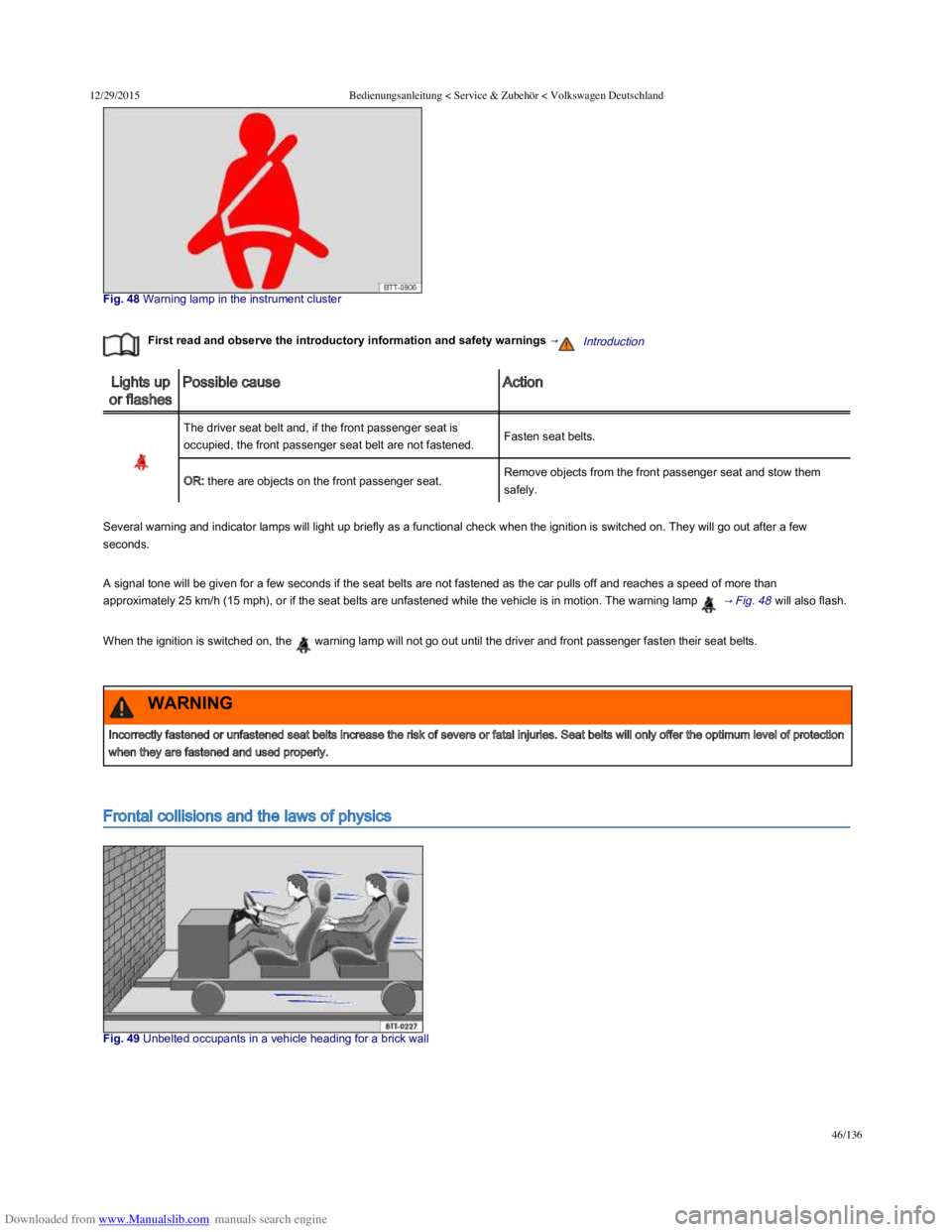
Downloaded from www.Manualslib.com manuals search engine 12/29/2015Bedienungsanleitung < Service & Zubehör < Volkswagen Deutschland
46/136
Fig. 48 Warning lamp in the instrument cluster
First read and observe the introductory information and safety warnings →Introduction
Lights up
or flashes
Possible causeAction
The driver seat belt and, if the front passenger seat is
occupied, the front passenger seat belt are not fastened.Fasten seat belts.
OR: there are objects on the front passenger seat.Remove objects from the front passenger seat and stow them
safely.
Several warning and indicator lamps will light up briefly as a functional check when the ignition is switched on. They will go out after a few
seconds.
A signal tone will be given for a few seconds if the seat belts are not fastened as the car pulls off and reaches a speed of more than
approximately 25 km/h (15 mph), or if the seat belts are unfastened while the vehicle is in motion. The warning lamp → Fig. 48 will also flash.
When the ignition is switched on, the warning lamp will not go out until the driver and front passenger fasten their seat belts.
Frontal collisions and the laws of physics
Fig. 49 Unbelted occupants in a vehicle heading for a brick wall
Incorrectly fastened or unfastened seat belts increase the risk of severe or fatal injuries. Seat belts will only offer the optimum level of protection
when they are fastened and used properly.
WARNING
Page 82 of 100
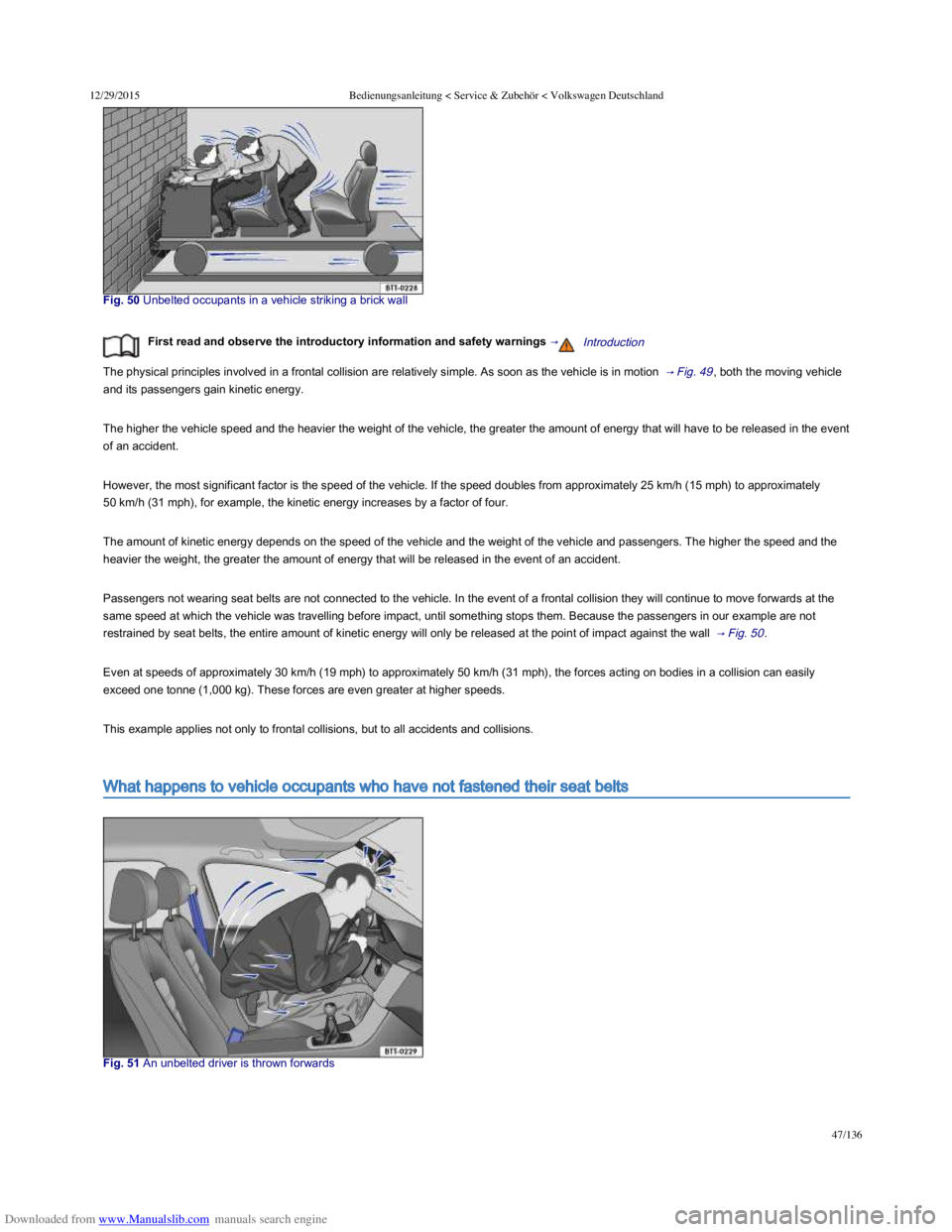
Downloaded from www.Manualslib.com manuals search engine 12/29/2015Bedienungsanleitung < Service & Zubehör < Volkswagen Deutschland
47/136
Fig. 50 Unbelted occupants in a vehicle striking a brick wall
First read and observe the introductory information and safety warnings →Introduction
The physical principles involved in a frontal collision are relatively simple. As soon as the vehicle is in motion → Fig. 49 , both the moving vehicle
and its passengers gain kinetic energy.
The higher the vehicle speed and the heavier the weight of the vehicle, the greater the amount of energy that will have to be released in the event
of an accident.
However, the most significant factor is the speed of the vehicle. If the speed doubles from approximately 25 km/h (15 mph) to approximately
50 km/h (31 mph), for example, the kinetic energy increases by a factor of four.
The amount of kinetic energy depends on the speed of the vehicle and the weight of the vehicle and passengers. The higher the speed and the
heavier the weight, the greater the amount of energy that will be released in the event of an accident.
Passengers not wearing seat belts are not connected to the vehicle. In the event of a frontal collision they will continue to move forwards at the
same speed at which the vehicle was travelling before impact, until something stops them. Because the passengers in our example are not
restrained by seat belts, the entire amount of kinetic energy will only be released at the point of impact against the wall → Fig. 50 .
Even at speeds of approximately 30 km/h (19 mph) to approximately 50 km/h (31 mph), the forces acting on bodies in a collision can easily
exceed one tonne (1,000 kg). These forces are even greater at higher speeds.
This example applies not only to frontal collisions, but to all accidents and collisions.
What happens to vehicle occupants who have not fastened their seat belts
Fig. 51 An unbelted driver is thrown forwards
Page 83 of 100
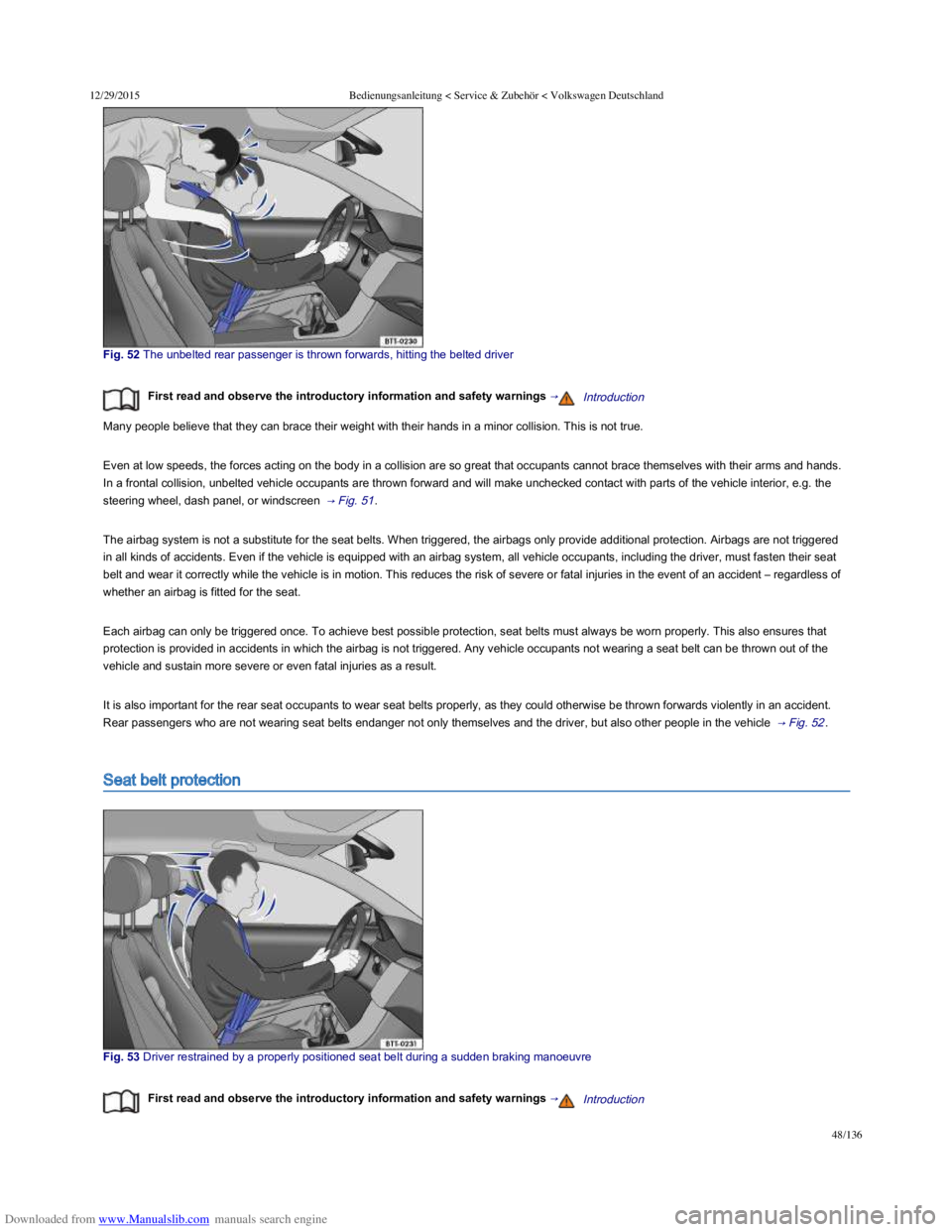
Downloaded from www.Manualslib.com manuals search engine 12/29/2015Bedienungsanleitung < Service & Zubehör < Volkswagen Deutschland
48/136
Fig. 52 The unbelted rear passenger is thrown forwards, hitting the belted driver
First read and observe the introductory information and safety warnings →Introduction
Many people believe that they can brace their weight with their hands in a minor collision. This is not true.
Even at low speeds, the forces acting on the body in a collision are so great that occupants cannot brace themselves with their arms and hands.
In a frontal collision, unbelted vehicle occupants are thrown forward and will make unchecked contact with parts of the vehicle interior, e.g. the
steering wheel, dash panel, or windscreen → Fig. 51 .
The airbag system is not a substitute for the seat belts. When triggered, the airbags only provide additional protection. Airbags are not triggered
in all kinds of accidents. Even if the vehicle is equipped with an airbag system, all vehicle occupants, including the driver, must fasten their seat
belt and wear it correctly while the vehicle is in motion. This reduces the risk of severe or fatal injuries in the event of an accident – regardless of
whether an airbag is fitted for the seat.
Each airbag can only be triggered once. To achieve best possible protection, seat belts must always be worn properly. This also ensures that
protection is provided in accidents in which the airbag is not triggered. Any vehicle occupants not wearing a seat belt can be thrown out of the
vehicle and sustain more severe or even fatal injuries as a result.
It is also important for the rear seat occupants to wear seat belts properly, as they could otherwise be thrown forwards violently in an accident.
Rear passengers who are not wearing seat belts endanger not only themselves and the driver, but also other people in the vehicle → Fig. 52 .
Seat belt protection
Fig. 53 Driver restrained by a properly positioned seat belt during a sudden braking manoeuvre
First read and observe the introductory information and safety warnings →Introduction